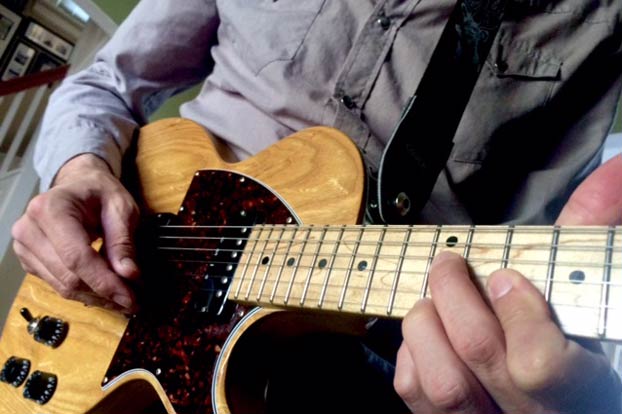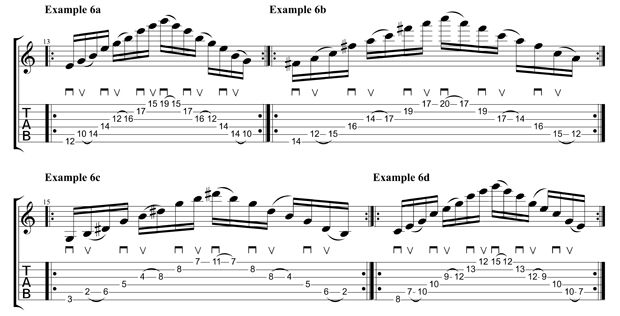The Guitarist's Guide to Shape Shifting, Part 1
Navigate greater expanses of fretboard terrain with this technique.

The technique is simple: Take a fingering pattern “shape” and shift it across the neck over three octaves.
Use of this technique can, however, impart a broader and more sophisticated scope to a lick while also acting as a no-brainer means of navigating greater expanses of fretboard terrain.
EXAMPLE 1 depicts three “target” notes (all A’s) in three octaves.
Play each note with your index finger to get used to the shift on the neck and the physical relationship between the fretboard locations of the note in each octave (You also can prime yourself for future examples by performing the example again with just the middle finger, then just the ring finger, then just the pinky).

Getting on with the aforementioned shapes, EXAMPLE 2 is the first six notes of an A Dorian #4 mode (the 4th mode of E harmonic minor), in two-string sets (E and A, D and G, B and E), moving up and then down the strings across three octaves. Note that the location of the #4 (D#, A string, sixth fret and G string, eighth fret) helps make the overall position shift from octave to octave less abrupt.

Where this shifting technique really comes alive is when it is applied to a short two-string lick within the pattern that is then repeated across the other octaves/string sets. EXAMPLE 3 takes a 16-note pattern in the first octave on the E and A strings and then repeats the pattern across the other two octaves, creating a fluid trip across a broad range, resolving on the E note.

EXAMPLE 4 is a fingering that is technically a D# Mixolydian #1 mode (the 7th mode of E harmonic minor, also known as the Super Locrian mode or Altered Dominant scale), though I like to think of the particular fingering as an E harmonic minor with the D# as a “lead-in” note to the main six-note Em pattern. Unlike the previous example’s six-note shape, this seven-note shape gains dimension to the overall two-string pattern by including an extra note on the lower string performed with an index finger slide (both notes picked).

EXAMPLE 5 is a descending Yngwie-style run using the shape.

This shape shifting technique is also quite adaptable to use with two-string triad arpeggios. Whereas the previous examples were designed to make the transitions between positions more fluid, the triad arpeggios require a clearer position shift/jump from octave to octave.
To that end, the 16th note loops in EXAMPLE 6 demonstrate the four different triad arpeggio shape types found in the key of E Harmonic Minor (the triad arpeggios in the key are: Em, F#mb5, G+, Am, B, C, D#mb5). EXAMPLE 6a is the standard minor shape (Em), EXAMPLE 6b is the minor flat 5 shape (F#), EXAMPLE 6c is the Augmented shape (G+) and EXAMPLE 6d is the major shape (C).

Pay careful attention to the picking, be firm and articulate with the hammers and pull-offs, and be sure to lead each new position with the middle finger as the target/anchor note.
I’ve only begun to dig into the potential of this shape shifting technique with the above examples. Next time, I’ll show you how to take it to the next level and beyond. Thanks for reading, stay tuned and happy shredding!
Scott Marano has dedicated his life to the study of the guitar, honing his chops at the Berklee College of Music under the tutelage of Jon Finn and Joe Stump and working as an accomplished guitarist, performer, songwriter and in-demand instructor. In 2007, Scott developed the Guitar Strength program to inspire and provide accelerated education to guitarists of all ages and in all styles through state-of-the-art private guitar lessons in his home state of Rhode Island and globally via Skype. Learn more at GuitarStrength.com.
Get The Pick Newsletter
All the latest guitar news, interviews, lessons, reviews, deals and more, direct to your inbox!
Scott Marano has dedicated his life to the study of the guitar, honing his chops at the Berklee College of Music under the tutelage of Jon Finn and Joe Stump and working as an accomplished guitarist, performer, songwriter and in-demand instructor. In 2007, Scott developed the Guitar Strength program to inspire and provide accelerated education to guitarists of all ages and in all styles through state-of-the-art private guitar lessons in his home state of Rhode Island and globally via Skype.
“There are so many sounds to be discovered when you get away from using a pick”: Jared James Nichols shows you how to add “snap, crackle and pop” to your playing with banjo rolls and string snaps
Don't let chord inversions bamboozle you. It's simply the case of shuffling the notes around







![Joe Bonamassa [left] wears a deep blue suit and polka-dotted shirt and plays his green refin Strat; the late Irish blues legend Rory Gallagher [right] screams and inflicts some punishment on his heavily worn number one Stratocaster.](https://cdn.mos.cms.futurecdn.net/cw28h7UBcTVfTLs7p7eiLe.jpg)


